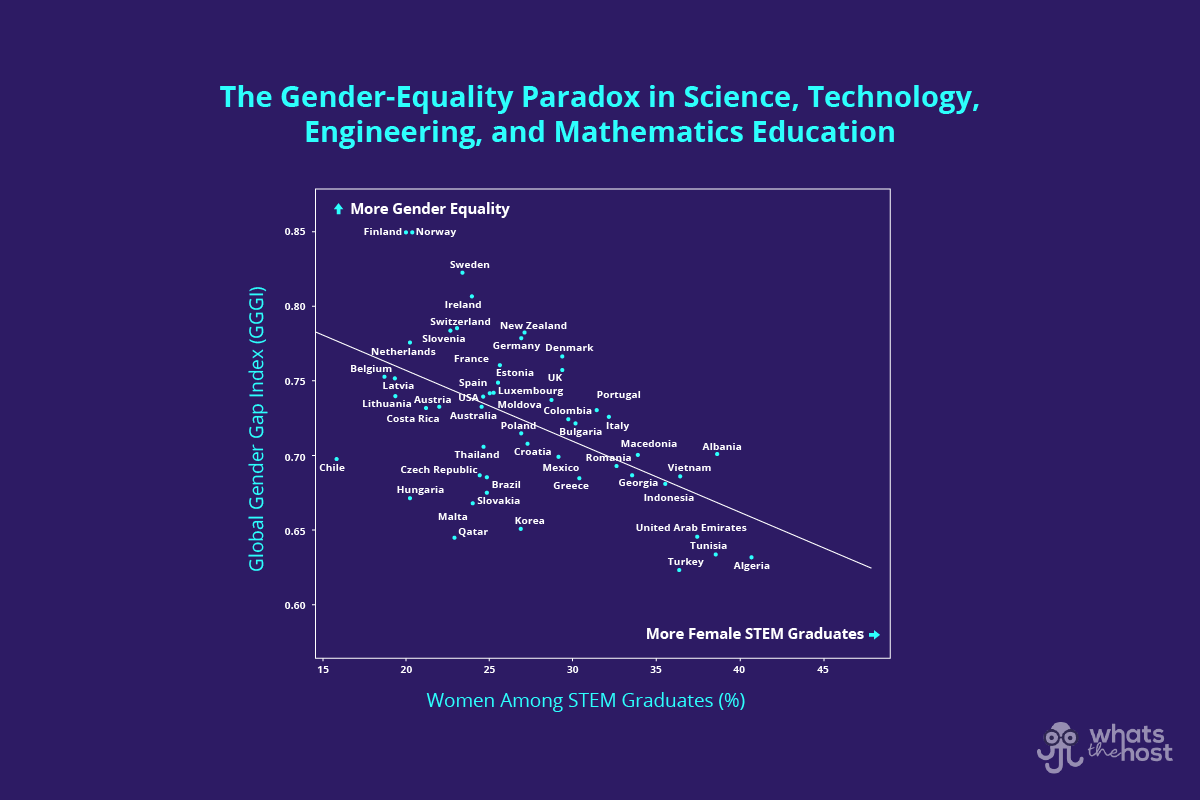The number of women studying and working in Science, Technology, Engineering, and Mathematics fields has grown in recent years. But despite this increase, and despite growing institutional emphasis on gender equality, the remains a stark gender disparity in STEM.
The STEM gender gap is one of the modern labor market’s most pressing issues. And its causes are as manifold as its consequences.
Though many valiant efforts to promote STEM careers among women and girls are making headway, the complicated legacy of male domination in the sciences is a difficult dragon to slay.
Solving the gender STEM gap will take more than simply getting more women to study these fields in higher education. It will also require addressing a long-running and fraught culture of exclusion.
Here are six fascinating yet troubling historical facts and current stats showing that increasing female participation in STEM is a complex challenge:
1. Countries with higher gender equality tend to have some of the lowest rates of women in STEM, while many countries with low gender equality have some of the highest rates of women in STEM.
You would think that more gender-equal countries would have higher numbers of women in STEM, right?
Surprisingly, the opposite is true. A 2018 study by Gijsbert Stoet of Leeds Beckett University and David C. Geary of the University of Missouri found that countries in which women and girls face greater obstacles to equality actually have some of the highest rates of women studying STEM subjects.
For example, in Indonesia, the UAE, Tunisia, Turkey, and Algeria, more than 35 percent of STEM graduates are women, despite these countries all scoring below 70 percent on the Global Gender Gap Index.
However, in countries with the highest GGGI scores, including Finland, Norway, Sweden, and Ireland, women represented less than 25 percent of STEM graduates.

The causes of this gender-equality paradox are still up for debate.
One theory comes from the authors of the study: women living in more misogynistic societies may be driven to study highly esteemed subjects as a means of improving the circumstances of their lives.
“Life satisfaction is higher in gender-equal countries,” posits Stoet. “And we think that when life satisfaction is higher, and people feel more secure in society, they feel they can do what they really like. They are less driven by economic interests.”
Another explanation, proposed by science journalist Angela Saini, is the “long legacy of exclusion” of women from science in countries of European heritage. Europeanized countries have a scientific and academic culture that expressly excluded women for centuries. Their academic institutions only began to accept large numbers of female students during the middle of the 20th century.
The mid-20th century was precisely the time when many of the first modernized institutions of higher education were established across the developing world. As such, most of these institutions have always accepted women students and may therefore have fewer gendered stereotypes about academic subjects.
2. Women account for 51.5 percent of undergraduate STEM enrollments in the UK. But this is mostly due to high proportions of women in life science subjects and low proportions of women in other STEM subjects.
On the surface, the fact that women account for slightly more than half of UK students pursuing undergraduate degrees in the sciences seems like a hallmark of equality. But this statistic by itself can be misleading. Looking at enrollments for individual STEM subjects paints a more accurate picture of gender representation.
As it turns out, there are certain STEM fields with significantly more women than men – namely those that fall under the umbrella of life sciences. However, there are other STEM fields in which women remain hugely under represented.

In the UK, women in life science fields are well represented in the academy. In fact, many of these fields have gender gaps that favor women. 90.5% of students studying nursing, for example, are women.
But it is a very different story for engineering, technology, and mathematics. Women remain underrepresented in these fields, in some cases being out-numbered by their male peers by more than 4 to 1.
3. In 2016, only 15 percent of undergrads majoring in Computer Science were women. However, 43 percent of students enrolled in coding bootcamp programs were women.
A 2016 study of U.S.-based coding bootcamp programs revealed that women were significantly better represented in private learn-to-write-code programs than in university Computer Science departments. While 43 percent of coding bootcamp students were female, only 15 percent of university Computer Science students were female.
This trend was similar for black and latinx students, who comprised only 10 percent of those formally studying Computer Science but 25 percent of those enrolled in coding bootcamps.
These findings suggest that alternative pathways to tech jobs may be more accessible to women and minorities than are 4-year degrees.
4. From WWII to the mid ‘60s, women comprised the largest trained technical workforce in the British computing industry.
During the Second World War, thousands women across the UK entered into the workforce in the emerging field of computing, where they wrote and cracked codes, calculated ballistic missile projections, and organized military logistics. About 8,000 women worked at Britain’s Bletchley Park cryptanalysis center during WWII, comprising about 75% of its workforce.
After the war, many of these women went on to work for civil services offices where they operated the computing systems in which government data processed – a job profile that was almost exclusively the realm of women.
By the mid ‘60s, the computing industry started to become more dominated by men. Marie Hicks’ book Programmed Inequality explores how experienced British women with technical skills were sidelined during this era to make room for less-experienced male workers, replacing feminized job titles like “Secretary” with masculinized, better-paying titles like “Computer Engineer.”
This mismanaged decision, Hicks argues, is largely responsible for why the British computing industry all but evaporated by the end of the 1970s.
5. In 1984, women accounted for 37 percent of bachelor’s degrees in Computer Science in the United States. By 2018, this number had declined to just 18 percent.
Until the mid ‘80s, the percentage of U.S. women in computer science had been on a steady upwards trend. After 1984, this development nose-dived and has never been able to quite recover.
NPR reports that the sudden plunge of women in computing could be explained by the emergence of personal computers, and the fact that the earliest PC models were marketed almost exclusively as toys for boys.
As more young men who had been tinkering with PCs since childhood began to enroll in university programs for computer science, they had a drastic leg up over their female peers in entry-level courses. This imbalance led women to be seen by their male peers and professors as less intelligent, thus discouraging women from entering the field.
This time period – the mid 80’s to early ‘90s – was a crucial window of opportunity that women ended up missing out on. Some of the richest people in tech today are men who had studied computer science during this era, and were therefore primed to seize on the Dotcom Boom of the late ‘90s.
This legacy of computers as toys for boys continues to this day. In the USA, 81 percent of high school students enrolled in AP Computer Science courses are male.
6. Female Nobel laureates in Physics, Chemistry, Economics, and Medicine and Physiology are 34% less likely to be married and 31% less likely to have children than male Nobel Laureates.
Between 2003 and 2018, ten women were awarded Nobel Prizes for Physics, Chemistry, Economics, or Medicine & Physiology. In the hundred years prior to 2003, only 10 women had ever been awarded Nobel Prizes. In total, only 20 women have won Nobel Prizes in these fields compared with 668 men.
While the fact that women are generally underrepresented in STEM fields can account for some of why these numbers are so low, a 2018 study in Palgrave Communications found that gender ratio alone cannot truly account for why there are so few female Nobel laureates.
By comparing the global distribution of women faculty members in these fields with the gender distribution of Nobel Prizes, the authors were able to determine there is a 96% probability that there is a bias against women in the distribution of Nobel Prizes.
The authors of this study do not propose that women nominees were unfairly evaluated by sexist committees; rather, they speculate “there are limitations for women to enter the pool of very well esteemed scientists worth of a nomination.”
One such hindrance the authors were able to examine was family life, pointing to the fact that while 97% of male Nobel Laureates were married and 86% had children, only 63% of female laureates were married and only 55% had children.
Last Updated on August 24, 2020 by Joe





